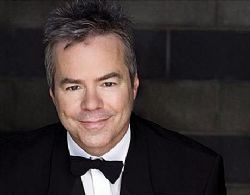|
Symphony
MYSTICAL PLANETS AND LIVELY GERSHWIN ORTIZ AT FINAL SRS CONCERT
by Peter Lert
Sunday, May 4, 2025
Symphony
VSO'S CONCERT MUSIC OF TIME, MUSIC OF PLACE
by Peter Lert
Sunday, April 27, 2025
Choral and Vocal
VOCAL ELEGANCE AND FIRE AT THE 222'S RECITAL APRIL 26
by Pamela Hicks Gailey
Saturday, April 26, 2025
CANTIAMO SONOMA SINGS AN INSPIRED GOOD FRIDAY MOZART REQUIEM CONCERT
by Pamela Hicks Gailey
Friday, April 18, 2025
DRAMATIC SHOSTAKOVICH SYMPHONY CLOSES PHILHARMONIC'S 25TH SEASON
by Terry McNeill
Sunday, April 13, 2025
LARGE COLLEGE OF MARIN AUDIENCE GREETS STOPHER ARTISTRY
by Terry McNeill
Saturday, April 5, 2025
Chamber
FRISSON DELIVERS SHIVERS OF DELIGHT
by Abby Wasserman
Sunday, March 30, 2025
OLD AND MOSTLY NEW IN SRS MARCH CONCERT IN WEILL
by Peter Lert
Saturday, March 22, 2025
Symphony
TWO FORMIDABLE SYMPHONIES AND PURPLE MOUNTAINS AT SRS CONCERT
by Peter Lert
Sunday, February 23, 2025
Chamber
THE PARKER CAPTURES DEMANDING ADES QUARTET AT RAC SEBASTOPOL CONCERT
by Peter Lert
Saturday, February 15, 2025
|
 |
 Violinist Frank Almond |
BRAWNEY ARTISTRY IN ALMOND-WOLFRAM MUSIC AT OAKMONT RECITAL
by Terry McNeill
Thursday, December 10, 2015
Scintillating string playing has always been a feature of the Music at Oakmont concerts, but Dec. 10’s recital by violinist Frank Almond and pianist William Wolfram was exceptionally virtuosic and musically convincing.
The cornerstone of the performance came in the second half with a brawny reading of a titular work in the violin repertoire, Beethoven’s dramatic A Major Sonata, Op. 47 (Kreutzer). Playing without score, as he did the entire recital, Mr. Almond managed the fast tempo broken thirds and sixths in the opening Adagio – Presto with aplomb, and surmounted the technical hurdles in the graceful slow movement of trills and lyrical lightness. The piece’s famous first measures before the pianist enters, where there is string movement from the second to third chord (both in thirds), and then thee pianist with broken sixth chords, were deftly played. It’s not easy to do.
In the Andante there was some note blurring in quick passages but the violinist’s playing was always clear, with alternating seconds, at the top of the instrument’s register. Mr. Wolfram had an amazing trill technique here, even and easily swelling from piano to forte. The finale was “off to the races” in tempo, making the most of the composer’s dazzling inventiveness and mastery.
Over 45 minutes, this “Kreutzer” with all the repeats was held beautifully together by the duo and was a potent musical achievement.
In older days violin recitals frequently began with a middle drawer baroque piece, sometimes Tartini’s Devil’s Trill or Didone Abbandonata, or the Vitali Chaconne, or some Geminiani. Mr. Almond performed the Tartini G Minor “Devil’s Trill,” a 14-minute work with a mostly continuo part for the piano. I think the Kreisler cadenza was selected, and the performance was at turns virtuosic and even splashy with pithy small slides and sometimes comely phrasing.
Before intermission two disparate pieces were played, one arguably the greatest single work for the solo violin, and the other a late romantic sonata by an unknown Swedish composer, Amanda Röntgen-Maier. From the late 1880s, the Sonata in B Minor has hints of Rubinstein, Grieg and especially Schumann, but easily stands on its own. Mr. Almond underscored a slow wistfulness in the Andantino – Allegrettoand his use of pizzicato moving into the coda with a delicate soft bow was captivating. Grieg’s music, especially the great C Minor Sonata, seems to influence the finale, and Mr. Wolfram gave its surging passion powerful pianism. The violinist was less persuasive in the last forceful bars that needed a more soaring violin line. In sum, a very good reading of an attractive Sonata that needs more concert exposure.
Mr. Almond then played the justly iconic Bach Chaconne (from the D minor Partita, BWV 1004), and it seemed too easy to compare his performance with Gil Shaham’s March transversal of all the solo Bach Sonatas and Partitas in nearby Weill Hall. Easy because Mr. Shaham was consistently fast with tempos, and Mr. Almond was uniformly fast in phrasing. Perhaps it was simply the artist’s mood on a rainy Thursday and the compressed succinct scales and agogics were certainly convincing in their way. But this great music can profit with taking a little more time before transitions in the variations, and adopting more elasticity in note values.
Mr. Almond was a witty and informative speaker to the 200 in Berger Auditorium, describing each work and charmingly referring to Robert Hayden, Music at Oakmont’s founder and the star of a birthday reception following in the hall after the recital. The artist also spoke of the relationship of his Stradivarius violin, called the “Lipinski,” to the compositions on the program. There is speculation that Carl Lipinski (1790-1861) played all the works in the program (save for the Röntgen-Maier Sonata) with this violin.
Clara Schumann’s Romance from Op. 22 was the one encore, played flawlessly with wide vibrato and luminous tone from both performers.
This was clearly one of the finest violin recitals in the North Bay in many years.
Bay area violinist Bronislaw Rabin contributed to this review.
|
